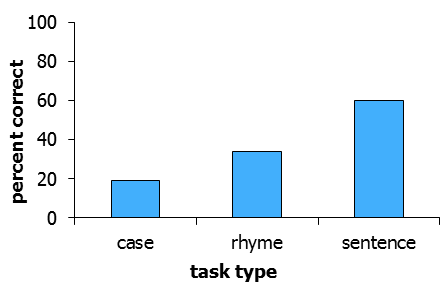
1. What is the serial position effect, and what is the evidence for it and against it?
2. What is the duration, capacity, and coding of the long-term store (LTS)?
3. Explain the differences between implicit and explicit memories.
4. How does Tulving categorize different kinds of memory? What does amnesia reveal about memory?
5. What is levels of processing theory, and what is the evidence for it and against it?
6. Describe how the encoding effects of self-reference and generation influence memory.
7. What is the testing effect and how does it work?
8. How do external context and internal states affect memory?
9. Describe how repetition, spacing of practice, interleaved practice, and sleep affect consolidation of memories.
10. How are memories stored in the brain?
11. Contrast the standard model of systems consolidation with the multiple trace theory of consolidation.
Glanzer & Cunitz (1966):
• gave participants lists of words to remember
• results:

• _______ effect: better recall for items at beginning of list; greater rehearsal causes transfer to LTS
• _______ effect: better recall of items at end of list, which were still in STS; mental math (recall delay) affected recency only
Problems:
![]() argument from _________
argument from _________
- memory varies along a continuum (short ↔ long)
- why have different memory systems?
- simpler to assume one memory system
![]() Craik & Watkins (1973): STS to LTS transfer
Craik & Watkins (1973): STS to LTS transfer
- participants heard a list of items; had to remember last word starting with “g”
e.g., daughter, oil, rifle, garden, grain, table, football, anchor, giraffe
- words differed in opportunities for rehearsal
e.g., giraffe value = 0; grain value = 4; garden value = 1
- participants did math task, then free recall of all words
- memory for “g” words:
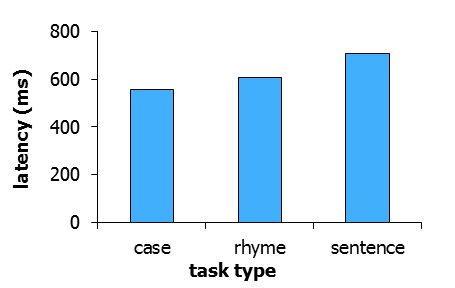
- no advantage for greater _________
![]() Bekerian & Baddeley (1980): role of repetition
Bekerian & Baddeley (1980): role of repetition
- BBC advertised new radio frequencies 10×/hour
- casual listener exposed to message 1,000×
- most listeners didn’t ________ the message
- repetition ≠ retention
(see next topic)
• Von Neumann (1958):
- calculation based on neural firing rate, estimated number of neurons, and a lifetime of 60 years
- 2.8 × 1020 bits, or about 1 exabyte (1 billion gigabytes)
• Landauer (1986):
- estimated “functional information content”: amount of information adults need to do normal tasks
- compared rate of information processing vs. forgetting on a number of tasks
e.g., reading, pictures, nonsense syllables
- people retain 2 bits/sec
- conclusion: adult LTS contains 109 bits, or 125 megabytes
- not the same as storage ________
• Reber (2010):
- the brain has ~100 billion neurons--but not all are involved in forming long-term memories
- ~1 billion neurons likely participate in memory × ~1,000 synapses each = 1012 (1 trillion) total synapses
- but each synapse does not store one memory
- rather, memories are ___________ across our brain’s neural networks, exponentially increasing capacity
- memory capacity estimated to be 2.5 petabytes (2.5 million gigabytes)
• bottom line: LTS capacity unknown; practically _________
• Shulman (1972):
- found that falsely recalled words had a similar _______
e.g., “baby” for “infant”, or “ship” for “boat”
- depended on position of list item: semantic confusions at _____ (words in LTM), acoustic confusions at ___ (words in STM)
- words that were held in LTS were coded by meaning
• however, LTS can also code physical details, like images
• ________ memory (a.k.a. declarative memory): conscious, intentional remembering of knowledge or an event
- ______: reproducing previously encountered information from memory
- ___________: identifying previously learned information
• ________ memory (a.k.a. nondeclarative memory): unconscious retention due to previous experience
- __________ _______ effect: previous experience with a stimulus facilitates later response to the same (or similar) stimulus
e.g., word-fragment completion: fill in missing letters from a word: D_ND_RS
e.g., word-stem completion: given the first few letters in a word, complete the word as fast as possible: “Dond...”
Endel Tulving (1972, 1985):
• ________ memory
- memory for events that occurred in your life
- tied to specific learning episode or experience
• ________ memory
- stores words, concepts, rules, abstract ideas
- general knowledge not tied to any experience
• __________ memory
- underlies motor & cognitive skills
- e.g., doing math, playing chess, riding a bike
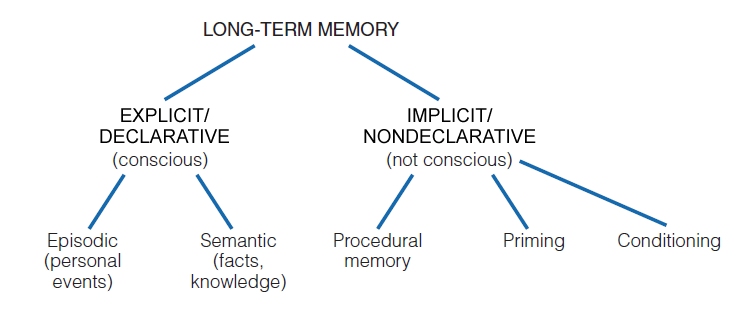
Evidence:
- certain patients with amnesia may have damaged one kind of memory system but have other ones intact (this is a ____________ effect: one specific ability is affected, but another is not)
• __________ amnesia: inability to remember events that occurred before a traumatic event
• ___________ amnesia: inability to form new memories of events that occurred after a traumatic event
The case of patient H.M. (Scoville & Milner, 1957; Corkin, 2013):
- had progressive uncontrolled epilepsy since age 10
- to control his seizures, had bilateral medial temporal lobe (MTL) resection at age 27 (in 1953)
- ___________, parahippocampal gyrus, and amygdala removed
- surgery was successful (fewer seizures), but resulted in profound amnesia
- normal IQ, STS (e.g., digit span), language (speech, writing, and reading)
- could remember events/facts in his distant past, but had __________ ______ retrograde amnesia for events 11 years before the surgery
- could not learn new facts or remember information about events since his surgery:
• could not find new home, even after 10 months
• language frozen in the _____
• forgot who he was talking to if he turned away
- however, he could form new __________ memories (e.g., mirror tracing task), but had no conscious recollection of previous training episodes
- see also Memory’s Ghost: The Strange Tale of Mr. M. and the Nature of Memory (Hilts, 1995) and Permanent Present Tense: The Unforgettable Life of the Amnesic Patient, H.M. (Corkin, 2013)
The case of patient K.C. (Moscovitch, Schacter, Tulving & colleagues, 2005):
- suffered a closed-head injury in a motorcycle collision in Toronto at age 30
- severe damage to MTLs and almost complete bilateral ___________ loss
- left-hemisphere lesions to posterior occipital-temporal and anterior frontal-parietal cortices
- personality changed from outgoing to more tranquil
- had retrograde amnesia for episodic memory, although ________ knowledge was intact
- also had some anterograde amnesia: no episodic memories formed after the accident (________ amnesia)
- but could form new semantic and procedural memories:
• played chess but did not remember playing a game
• knew where family cottage was but did not remember ever going there
• learned the Dewey decimal system for his job at the library, but did not know when he learned it
Conclusions:
• unimpaired STS implies it is biologically _________ from LTS
• hippocampus (and MTL?) not a storage site, but important for _____________ of explicit memories (STS to LTS transfer)
• H.M. provides evidence that implicit memory is ___________ from explicit memory
• K.C. provides evidence that, within ________ memory, semantic memory is dissociated from episodic memory
Levels of Processing Theory (Fergus I.M. Craik & Lockhart, 1972):
Encoding processes:
• shallow (e.g., __________: based on appearance of a word)
• intermediate (e.g., ________: based on sound of a word)
• deep (e.g., ________: based on meaning of a word)
“Deeper” encoding enhances memory. Why?
• ___________ rehearsal: repetitive processing
e.g., repeating a phone number over and over
• ___________ rehearsal: more meaningful processing, relating item to other knowledge
e.g., grouping digits in a phone number into meaningful patterns
- may work by organizing, connecting, or integrating memories (Bellezza et al., 1977; Mandler, 1979)
Evidence:
Craik & Tulving (1975):
- participants given a list of words; asked to do one of three tasks:
• case: Is the word in capital letters?
• rhyme: Does the word rhyme with weight?
• sentence: Does the word fit in this sentence: “He met a _____ in the street”?
- measured recognition performance and latency on incidental (surprise) memory test
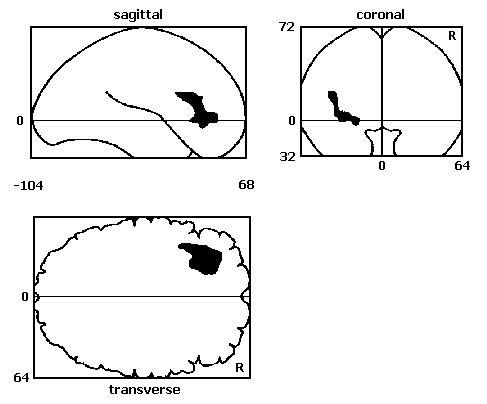
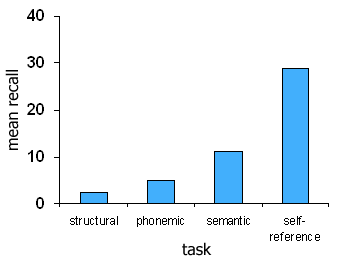
- is performance due to processing ____?
• structural task: Does word match this pattern of consonants and vowels?
e.g. CCVVC
• semantic task: Does word fit in this sentence?
e.g., “The man threw a ball to the ______.”
- results:
Task: |
Time |
Recognition |
structural |
1.70 s |
57% |
semantic |
0.83 s |
82% |
- depth of processing more important than processing ____
Problems:
![]() What does “______” mean?
What does “______” mean?
- ________ definition: deeper ![]() better memory
better memory
![]() Morris, Bransford, & Franks (1977): marching encoding and retrieval
Morris, Bransford, & Franks (1977): marching encoding and retrieval
- encoding task: given the word table
• phonetic/rhyming: Does it rhyme with cable?
• semantic: Does it fit in this sentence?
“Put the dish on the _____.”
- incidental recognition tests:
• phonetic/rhyming: Circle what rhymes with word presented earlier:
Fable Desk Window
• semantic: Circle word presented earlier:
Table Desk Window
- results:
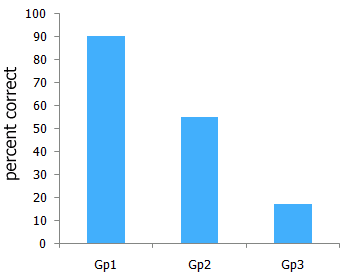
- memory performance not dependent on depth alone
- also depends on _____ between encoding processes and type of test: transfer-appropriate processing
e.g., driving or walking a route several times helps you remember it better than just looking at a map
![]() Kapur, Craik, Tulving, & colleagues (1994):
Kapur, Craik, Tulving, & colleagues (1994):
- shallow task: Does the word contain the letter a ?
- deep task: Does word represent a living thing?
- better recognition for deep task
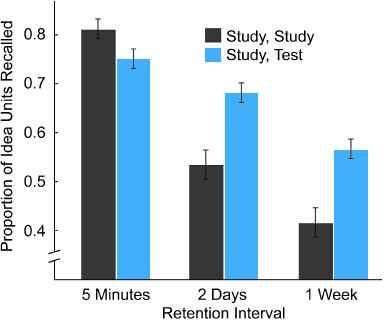
- greater activation in left inferior __________ cortex during a deep task
- shows more activity, not deeper activity
____-_________ effect (Rogers, Kuiper, & Kirker, 1977): memory is enhanced by relating items to one’s self
- presented 40 adjectives to participants
e.g., kind, rigid, brave, etc.
- words evaluated one of four ways:
• structural, phonemic, or semantic tasks
• ____-_________ group asked if each adjective described them
- results of incidental recall test:
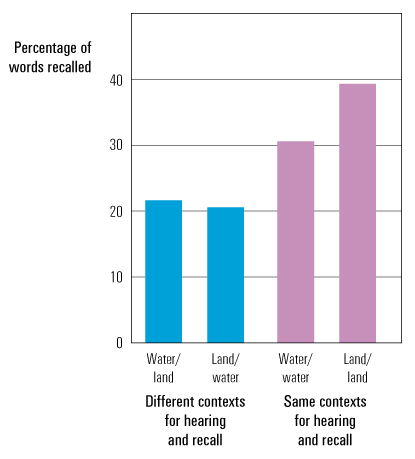
- self-reference group surpassed semantic encoding group
__________ effect (Mäntylä, 1986): memory is enhanced for items that are actively produced
- presented 600 nouns (e.g., banana, freedom, tree)
- task: generate 3 cue words associated with each noun (e.g., yellow, bunches, edible for banana)
• Gp1: generated cue words
• Gp2: saw the nouns, and the 3 cue words generated by other participants
• Gp3: just saw the 3 cue words generated by other participants
- results of incidental recall test of nouns:
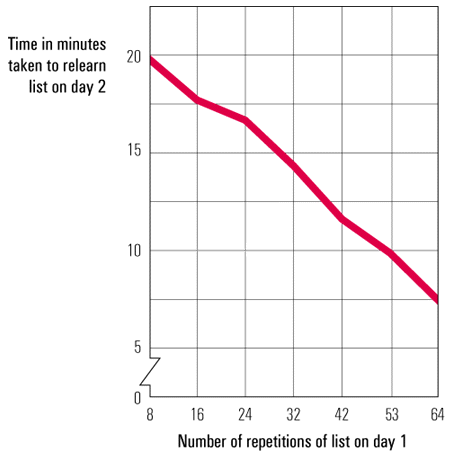
- self-generated cues lead to better remembering
- cues were most helpful when they were both __________ with the target word and ___________
e.g., given the noun coat, the cue jacket is compatible and distinctive, but wool is not (it may cue other nouns like fabric and sheep)
Testing effect (Roediger & Karpicke, 2006):
- stimuli: two prose passages from TOEFL prep book (~260 words each)
- learning conditions:
• study, study: 7 minutes of studying, retention interval, another 7 minutes of studying
• study, test: 7 minutes of studying, retention interval, 7 minutes of testing
- retention interval:
• 5 minutes, 2 days, or 1 week
- results:
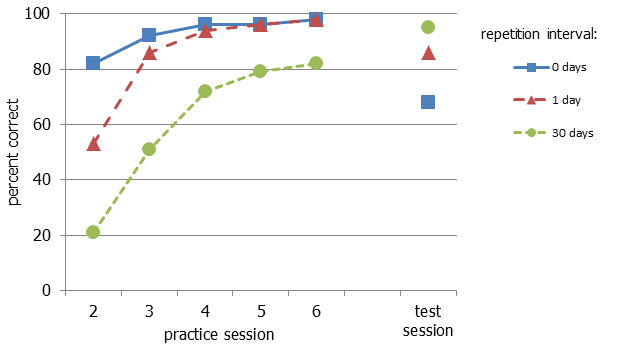
- conclusion: _______ (via retrieval practice) improves long-term retention
How does the testing effect work?
• additional (focused) presentation of material
• _________ itself is a memory modifier, with increasing retrieval demand/effort enhancing later retention
• processes applied during an initial test are also used during the final test, resulting in positive transfer (i.e., a ________ effect)
Encoding specificity principle: if conditions at retrieval match those at encoding, memory is enhanced (Tulving & Thomson, 1973)
• _______-_________ memory: memory enhancement that occurs when retrieval context matches encoding context
Godden & Baddeley (1975):
- scuba divers given a list of 36 unrelated words via diver underwater communication sets:
a) underwater, or b) on land
- recalled words in same (matched) or different (mismatched) context
- results:

• different contexts: 24% correct
• same context: 35% correct
- evidence for context-dependent memory
- strong ____________ for scuba divers & remembering!
Context effects obtained for:
• music: Mozart vs. jazz vs. quiet (Smith, 1985)
• background colours (Dulsky, 1935)
• smell of _________ (Schab, 1990), but not unpleasant odours (Rotton, 1983)
Bjork & colleagues (1978):
- participants given a list of 40 four-letter nouns, studied in two sessions
- sessions were held in the same room _____, or in two different rooms:
• context 1: small, cluttered, windowless room
• context 2: room in a modern building with windows overlooking a courtyard
- students were tested in a third, “neutral” room
- results:
• students who studied in the same room twice: 40% correct
• students who studied in two different rooms: 61% correct
- implication: studying in a variety of contexts leads to better remembering, greater stability and “________________” of knowledge
• _____-_________ memory: if internal state during retrieval matches that during encoding, memory may be enhanced
e.g., mood or emotional state, physiological arousal, sober/_____ states (Eich, 1980)
• mood __________: when mood at retrieval matches the mood at encoding, memory is facilitated--however, the memories themselves are typically not emotional in nature (Lewis & Critchley, 2003)
• mood __________: mood at retrieval influences the kind of memories retrieved
e.g., in a sad mood, you’re more likely to remember sad events
- implicated in vicious cycle of depression (Baddeley, 1993)
_____________: process of integrating new information into stored knowledge
• savings curve (Ebbinghaus, 1885):
- more initial ________ ![]() less time to relearn list of nonsense syllables the next day (savings)
less time to relearn list of nonsense syllables the next day (savings)

• spacing effect (Bahrick, 1979):
- participants learned English translations for 50 Spanish words by completing six training sessions
- kinds of training:
▸ ______ practice: information studied repeatedly at one time
▸ ___________ practice (or spaced repetition): information studied repeatedly in separate sessions over a longer period of time
- independent variable: spacing gap
▸ 0 days (massed practice)
▸ 1 day (distributed practice)
▸ 30 days (distributed practice)
- participants were given a final test 1 month after the last training session
- results:
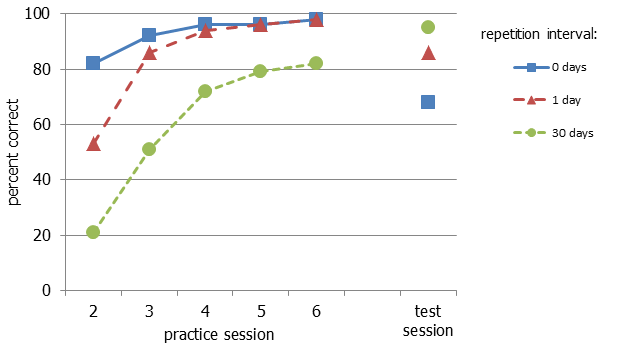
▸ greater spacing between training sessions produced better remembering
▸ follow-up study 8 years later showed 30-day spacing group outperformed the other two (Bahrick & Phelps, 1987)
- _______ effect: distributed practice produces better remembering than massed practice
- why?
▸ multiple ________ ________ theory: multiple study sessions lead to multiple types of encoding, thus greater chance of matching during test conditions
▸ ___ theory: the more rapid eye movement sessions following study sessions, the more consolidation that occurs
Kornell & Bjork (2008): interleaved practice
- goal: identify painting styles of different artists by inductive learning (observing _________)
- stimuli were multiple landscape paintings by relatively unfamiliar artists, including Henri-Edmond Cross, Marilyn Mylrea, and YeiMei
- independent variable was the nature of practice
▸ _______ practice: participants studied artists one at a time (e.g., 6 paintings by Cross presented consecutively, followed by 6 by Mylrea, etc.)
▸ ___________ practice: participants studied artists mixed up (e.g., 1 painting by Cross, then 1 by YeiMei, then 1 by Mylrea, etc.)
- both groups studied 6 paintings by each of 12 artists, then were tested with 4 previously unseen paintings each of the 12 artists
- results:
▸ blocked: 50% correct
▸ interleaved: ___ correct
- in one experiment, participants experienced both blocked and interleaved practice: 78% of participants did better with interleaved practice
- but when asked to rate practice effectiveness, ___ rated blocking as good as (or better than) interleaving
- conclusion: ____________ enhances inductive learning of concepts and categories
- implications: even though it may seem less effective, to maximize learning of different concepts, multiple examples should be presented and practiced interleaved
- interleaving has been shown to work in basketball, baseball, identifying birds, electrocardiogram interpretation, learning microsurgery, and assessing complex legal scenarios
- may work by requiring the learner to differentiate among related concepts, or to retrieve the correct strategy for each different type of problem
• spaced vs. interleaved practice:
- interleaving can be seen as a subtype of spacing


• David Hartley (1791) was the first to suggest ________ might alter the strength of associative memories
• ___ sleep was discovered by Aserinski & Kleitman (1953); linked it to dreaming
• REM sleep has been found to improve learning complex _____ games, foreign ________ acquisition, visual discrimination tasks, and intensive ________
• may be due to ___________ brain activity, neuronal replay (reactivation of neural patterns that are similar to those experienced during waking), changes in _______________, or regional brain activation (Stickgold, Hobson, Fosse, & Fosse, 2001)
Contradictory evidence (Siegel, 2001; Vertes & Eastman, 2000):
• results of animal studies are equivocal: REM deprivation does not necessarily impair learning/memory
• REM deprivation confounded with ______
• some _______________ suppress REM sleep, but learning/memory is not disrupted
• bilateral lesions of ____ abolish REM sleep, but patients led normal lives
• conclusion: REM sleep has no role in _____________
What about the effects of sleep overall?
• sleep deprivation reduces _______ memory by 38%
• sleep increases performance of procedural memories, like motor skill learning
• daytime ____ enhance declarative memories, maze learning, complex visual stimuli, paired words); performance correlated with the amount of NREM (non-REM) sleep
Conclusions:
• sleep has an important role in memory, attention, and executive function (Lowe et al., 2017)
• sleep actively promotes __________ of information learned during wakefulness
• sleep is important, not only for memory consolidation, but also for memory ___________
Dual trace hypothesis (Donald Hebb, 1949):
- memory formation (synaptic consolidation) requires two processes:
1. short term: experience causes activity in certain neural ________
2. longer term: continuous or repeated activity creates ______ change in nervous system
- “neurons that fire together, wire together”
- found in ____-____ potentiation (LTP): electrically induced changes in neural response (Hawkins & Kandel, 1984)
- kinds of neural change found to support learning:
• increased ________________ released
• increased ____ of postsynaptic region
• ____ synapses formed
Standard Model of Systems Consolidation (Squire & Alvarez, 1995):
- initially, incoming information activates cortical areas (e.g., for vision, audition, etc.), and is integrated and coordinated by the hippocampus into a memory trace
- consolidation occurs via ____________:
• hippocampus reactivates connections to the cortex associated with a memory
• occurs during sleep or by conscious rehearsal of a memory
- after repeated reactivation, long-lasting cortical interconnections are strengthened and/or new connections established
• new memories are integrated with existing ones
• activity in the hippocampus is no longer required
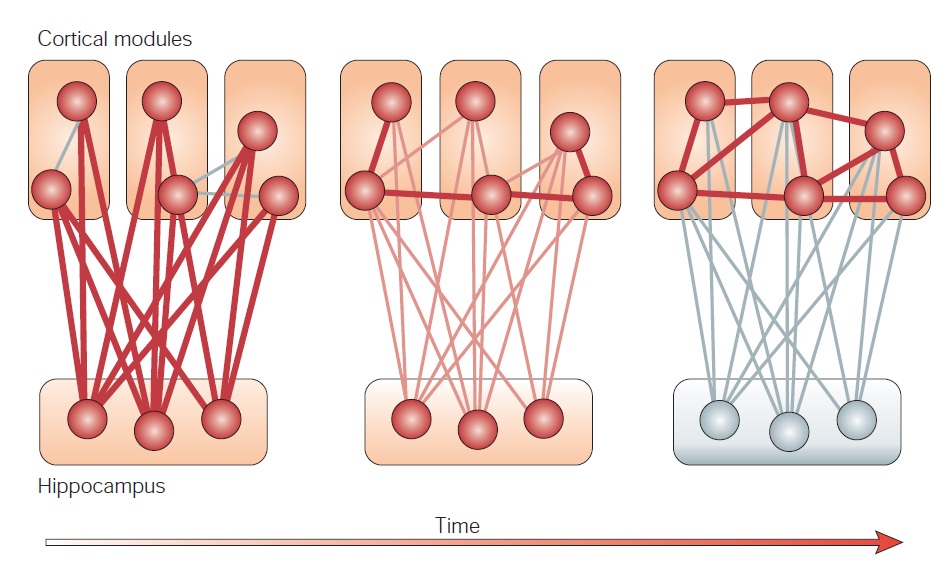
- predicts that retrograde amnesia (due to damaged hippocampus) should be temporally graded: memories formed closest in time to the traumatic event are most likely to be lost
Multiple Trace Theory of Consolidation (Nadel & Moscovitch, 1997)
- proposes that semantic memories stored in the cortex gradually become ___________ of the hippocampus (as in the Standard Model)
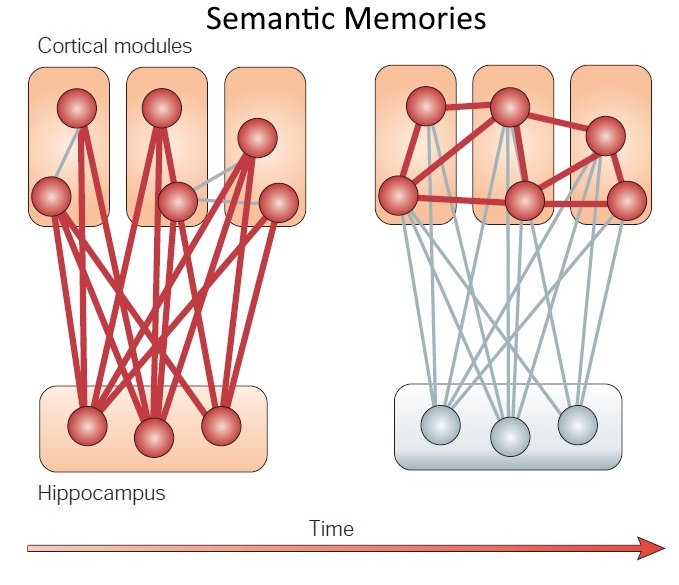
- in contrast, all episodic memories always involve the hippocampus, which provides spatial and temporal context (where and when)
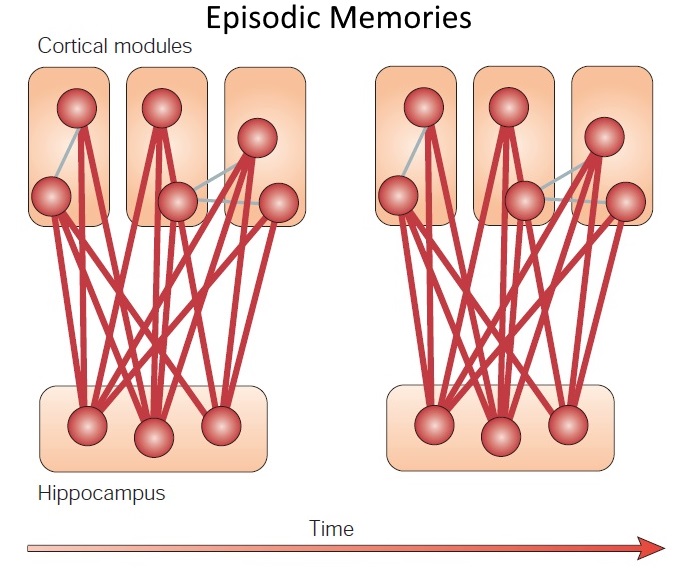
- predicts that complete lesions of the hippocampus should impair all episodic memories--whether recent or remote